Effect of Interaction Between Expandable Minerals and Glycerin-Based Fluids on the Occurrence of Accretion
Abstract
1. Introduction
2. Materials and Methods
2.1. Materials
2.2. Methods
2.2.1. Pellets’ Characterization
2.2.2. Drilling Fluids’ Preparation
2.2.3. Interaction Between Expandable Minerals and Drilling Fluids: Accretion Test
3. Results and Discussion
3.1. Pellets’ Characterization
3.1.1. Mineralogical Composition Section
3.1.2. Atterberg Limits
3.2. Interaction Between Expendable Minerals and Drilling Fluids
4. Conclusions
- The characterization of bentonite pellets revealed a predominance of clay minerals of the smectite group in their composition, which provides a strong indication of their reactivity with a high degree of expansion;
- According to the liquid limit, the pellets were categorized as presenting very high plasticity in the presence of water, high plasticity in the presence of water with glycerin, and intermediate plasticity in the presence of glycerin;
- Based on the degree of plasticity, it was found that the pellets were classified as highly plastic both in contact with water and water with glycerin;
- The accretion percentages were considerable for all drilling fluids at different times of the accretion test, indicating that the addition of glycerin to the fluids was not efficient in stabilizing the reactive formations;
- The use of inhibitors I1, I2, and I3, alone or together, did not demonstrate effectiveness in reducing the accretion phenomenon;
- For future research, it is recommended to investigate the compositions of fluids with varying glycerin concentrations, as well as to evaluate additional commercial inhibitors beyond those already analyzed.
Author Contributions
Funding
Data Availability Statement
Acknowledgments
Conflicts of Interest
References
- Frydman, M.; Fontoura, S.A.B. Modeling Aspects of Wellbore Stability in Shales. In Proceedings of the SPE Latin American and Caribbean Petroleum Engineering Conference, Buenos Aires, Argentina, 25–28 March 2001. [Google Scholar]
- Grim, R.E. Clay Mineralogy, 2nd ed.; McGraw-Hill: New York, NY, USA, 1968. [Google Scholar]
- Fuenkajorn, K.; Daemen, J.J.K. Drilling-Induced Fractures in Borehole Walls. J. Pet. Technol. 1992, 44, 210–216. [Google Scholar] [CrossRef]
- Reid, P.I.; Minton, R.C.; Twynam, A. Field Evaluation of a Novel Inhibitive Water-Based Drilling Fluid for Tertiary Shales. In Proceedings of the European Petroleum Conference, Cannes, France, 16–18 November 1992. [Google Scholar]
- Pormerlau, D.G. Glycerol Based Drilling Fluids. U.S. Patent No. 2009/0143254 A1, 4 June 2009. [Google Scholar]
- Associação Brasileira de Normas Técnicas (ABNT). NBR 6459: Solo-Determinação do Limite de Liquidez; ABNT: Rio de Janeiro, Brasil, 2016. [Google Scholar]
- Associação Brasileira de Normas Técnicas (ABNT). NBR 7180: Solo-Determinação do Limite de Plasticidade; ABNT: Rio de Janeiro, Brasil, 2016. [Google Scholar]
- Cliffe, S.; Young, S. Agglomeration and Accretion of Drill Cuttings in Water-based Fluids. In Proceedings of the AADE Fluids Conference and Exhibition, Houston, TX, USA, 8–9 April 2008. [Google Scholar]
- Wilson, M.J.; Wilson, L.; Patey, I. The influence of individual clay minerals on formation damage of reservoir sandstones: A critical review with some new insights. Clay Min. 2014, 49, 147–164. [Google Scholar] [CrossRef]
- Macedo, R.S.; Menezes, R.R.; Neves, G.A.; Ferreira, H.C. Study of clays used in red ceramic. Cerâmica 2008, 54, 411–417. [Google Scholar] [CrossRef]
- Apolônio, T.G.; Amorim, L.V.; Leal, C.A. Correlação entre a Composição Química e Mineralógica e as Características Plásticas de Folhelhos do Nordeste do Brasil. Rev. Eletrônica Mater. Process. 2020, 15, 102–109. [Google Scholar]
- Bell, F.G. Engineering Geology, 2nd ed.; Elsevier: London, UK, 2007. [Google Scholar]
- Couto, B.O.C.; Pereira, E.L.; Gomes, R.C.; Ferreira, L.D. Correlação entre os Valores do Limite de Liquidez Obtidos pelos Métodos de Casagrande e Cone de Queda Livre para Diferentes Materiais. In Proceedings of the XVIII Brazilian Congress of Soil Mechanics and Geotechnical Engineering–COBRAMSEG, Belo Horizonte, Brazil, 19–22 October 2016. [Google Scholar]
- Caputo, H.M. Mecânica dos Solos e Suas Aplicações, 6th ed.; LTC: Rio de Janeiro, Brazil, 1988. [Google Scholar]
- Van Oort, E.; Bland, R.; Pessier, R. Drilling more Stable Wells Faster and Cheaper with PDC Bits and Water Based Muds. In Proceedings of the IADC/SPE Drilling Conference, New Orleans, LA, USA, 23–25 February 2000. [Google Scholar]
- Hajjaji, W.; Moussi, B.; Hachani, M.; Mounir, M.; Galindo, A.; Rocha, F.; Labrincha, J.; Jamoussi, F. The Potential Use of Tithonian–Barremian Detrital Deposits from Central Tunisia as Raw Materials for Ceramic Tiles and Pigments. Appl. Clay Sci. 2010, 48, 552–560. [Google Scholar] [CrossRef]
- Fontoura, S.A.B. Lade and Modified Lade 3D Rock Strength Criteria. Rock Mech. Rock Eng. 2012, 45, 1001–1006. [Google Scholar] [CrossRef]
- Pivovarski, R.G.; Daroz, V.; Lugarini, A.; Franco, A.T.; Loureiro, S.; Waldmann, A.T.A.; Martins, A.L. I Testes de Hidratação Estáticos e Dinâmicos de Pellets de Bentonita para P&A. In Proceedings of the Encontro Nacional de Construção de Poços de Petróleo e Gás, Serra Negra, Brazil, 9–22 August 2019. [Google Scholar]
- Campos, L.F.A.; Macedo, R.S.; Kiyohara, P.K.; Ferreira, H.C. Plasticity characteristics of clays for use in structural clay products. Cerâmica 1999, 45, 140–145. [Google Scholar] [CrossRef]
- Steiger, R.P. Nontoxic, Nonchloride, Water-Base, Inhibitive Fluid to Stabilize Water Sensitive Shale 1993. US Patent No. 5198415, 30 March 1993. [Google Scholar]
- Bradley, W.F. Molecular Associations between Montmorillonite and Some Polyfunctional Organic Liquids. J. Am. Chem. Soc. 1945, 67, 975–981. [Google Scholar] [CrossRef]
- Bloys, B.; Davis, N.; Smolen, B.; Bailey, L.; Houwen, O.; Reid, P.; Sherwood, J.; Fraser, L.; Hodder, M. Designing and managing drilling fluid. Oilfield Rev. 1994, 6, 33–43. [Google Scholar]

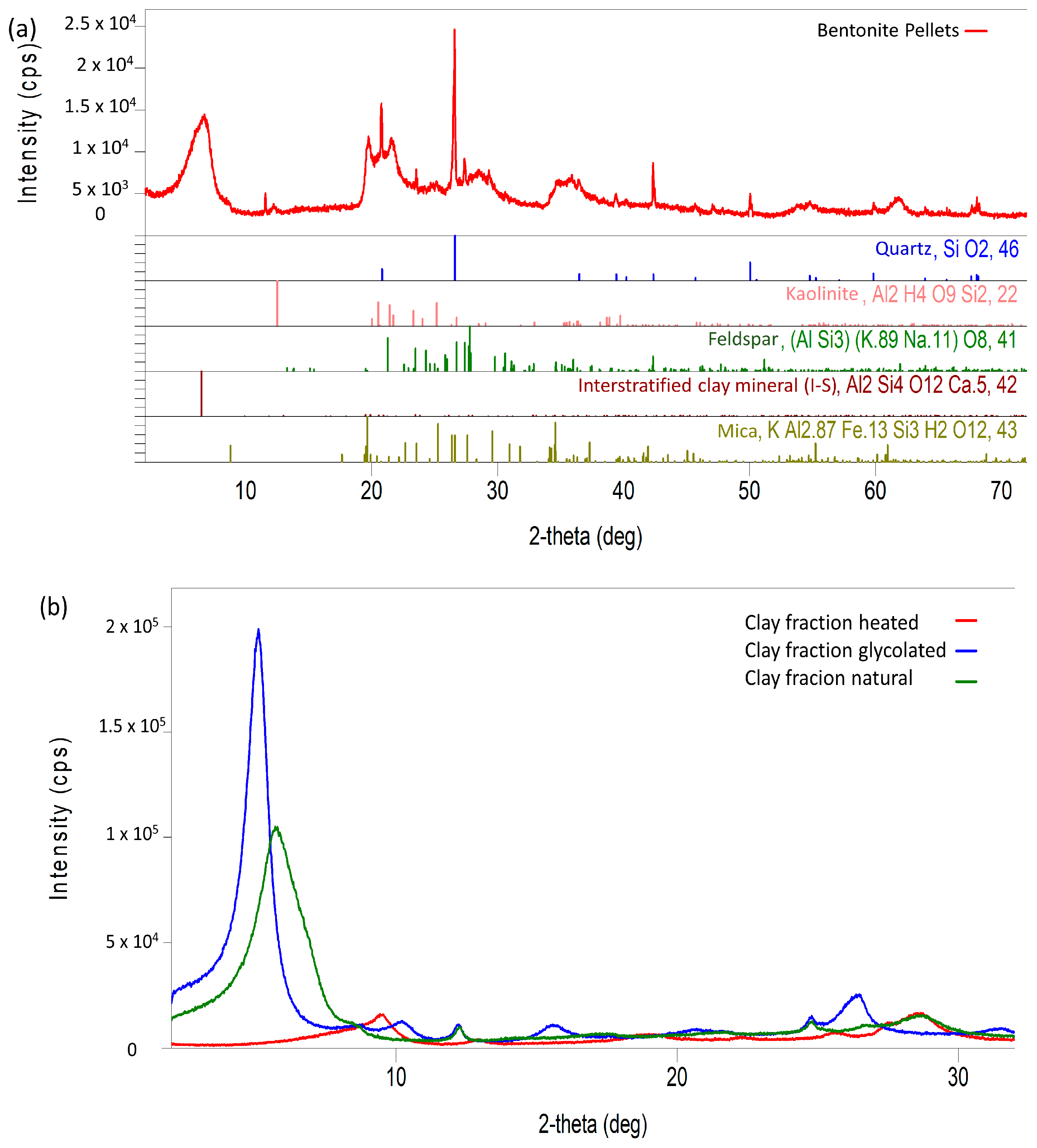
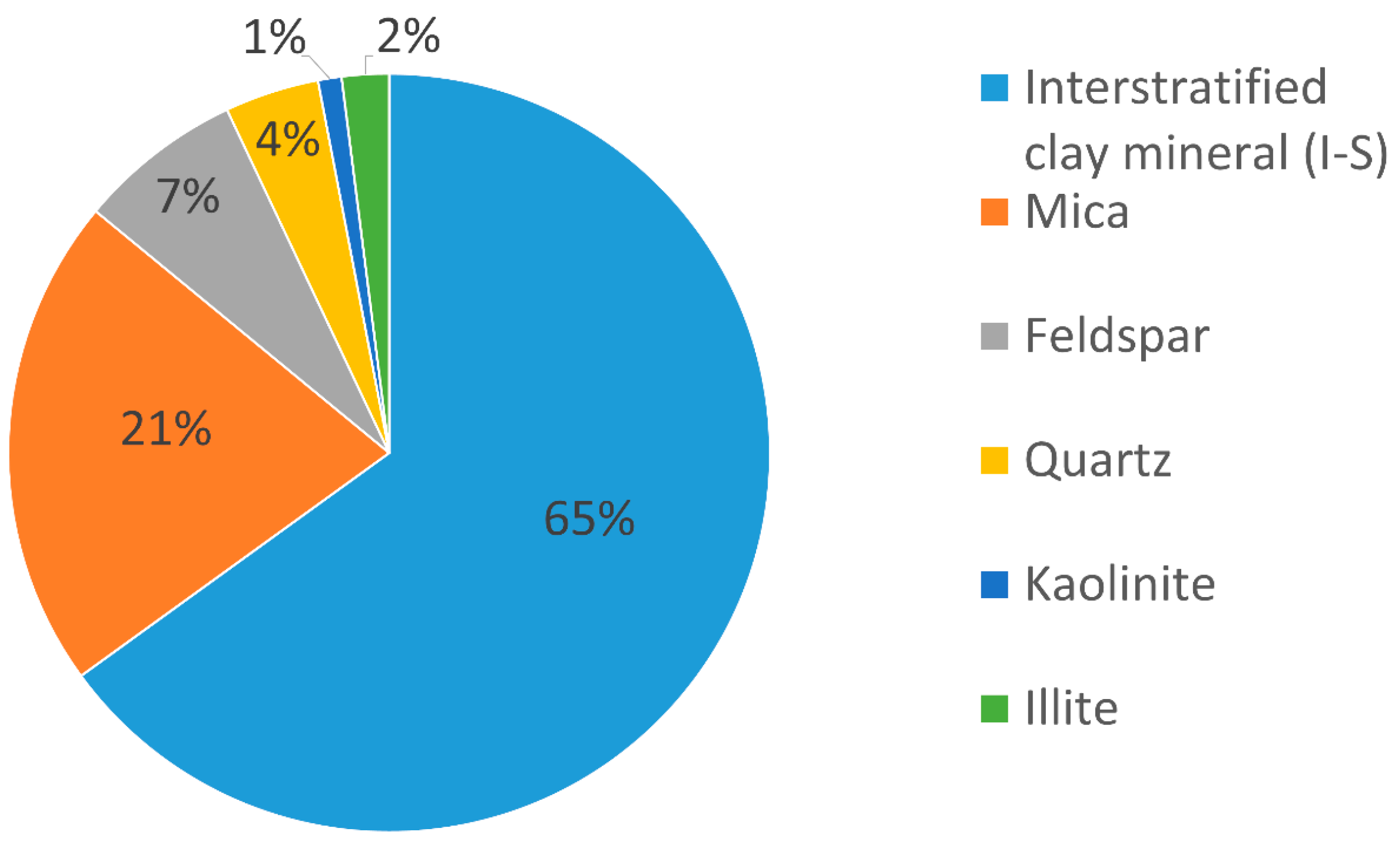
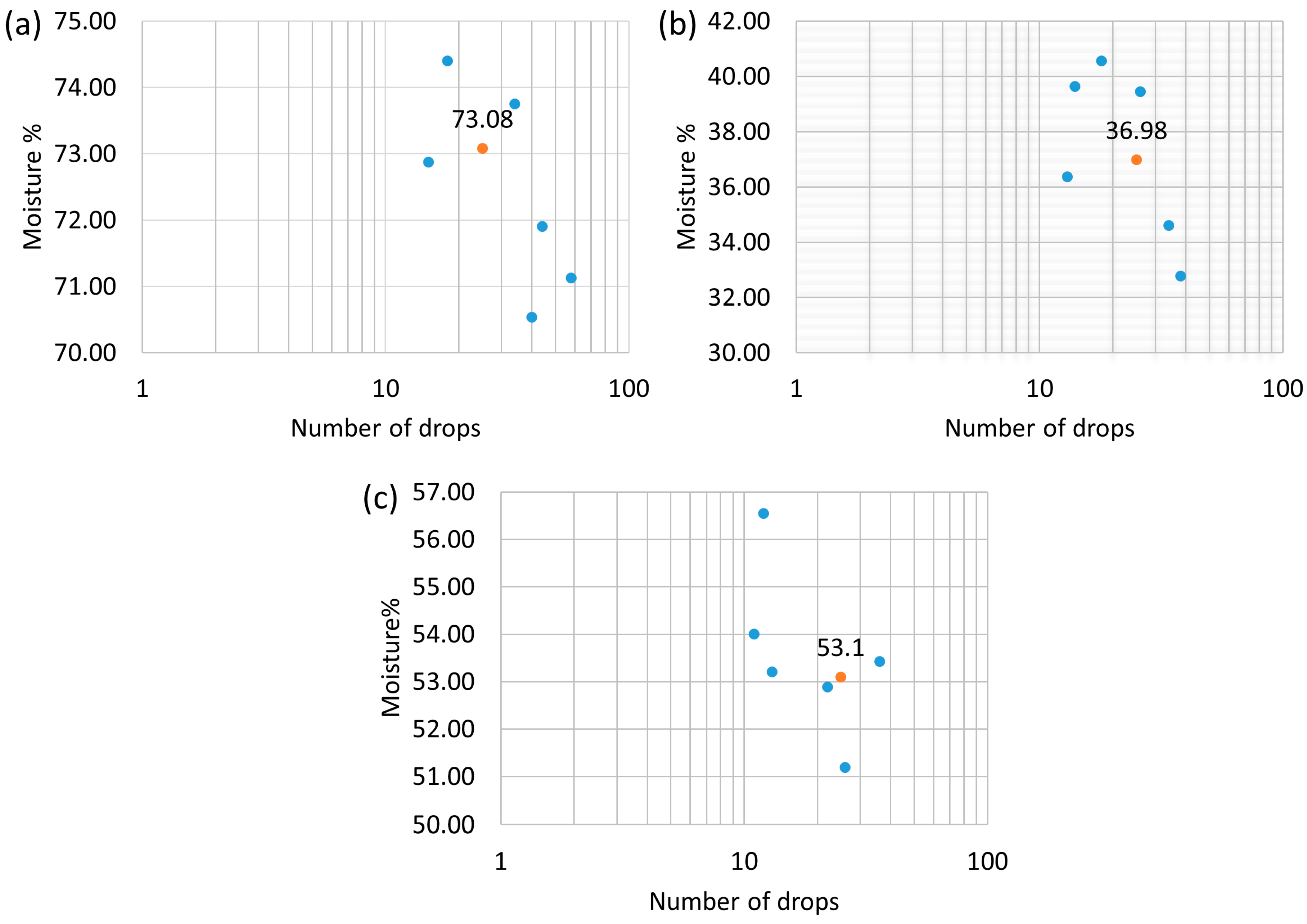
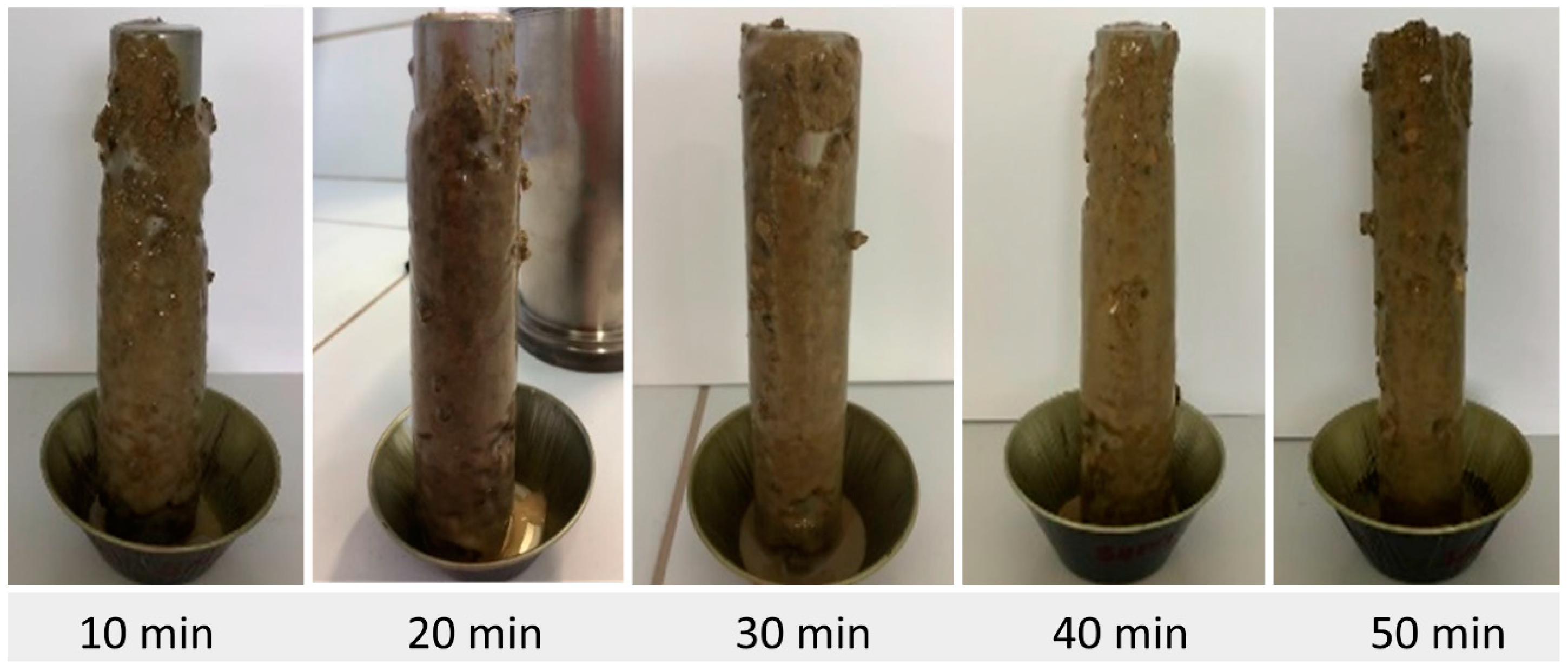
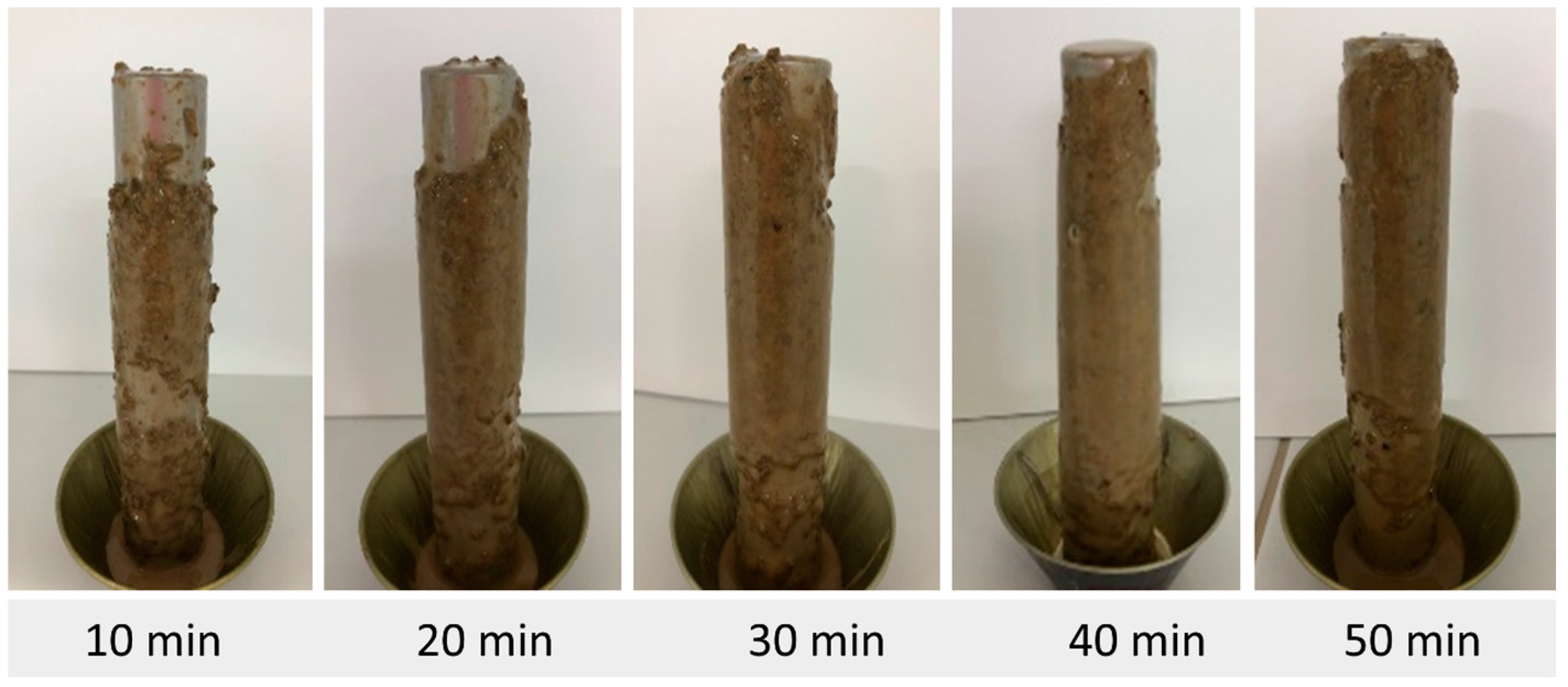
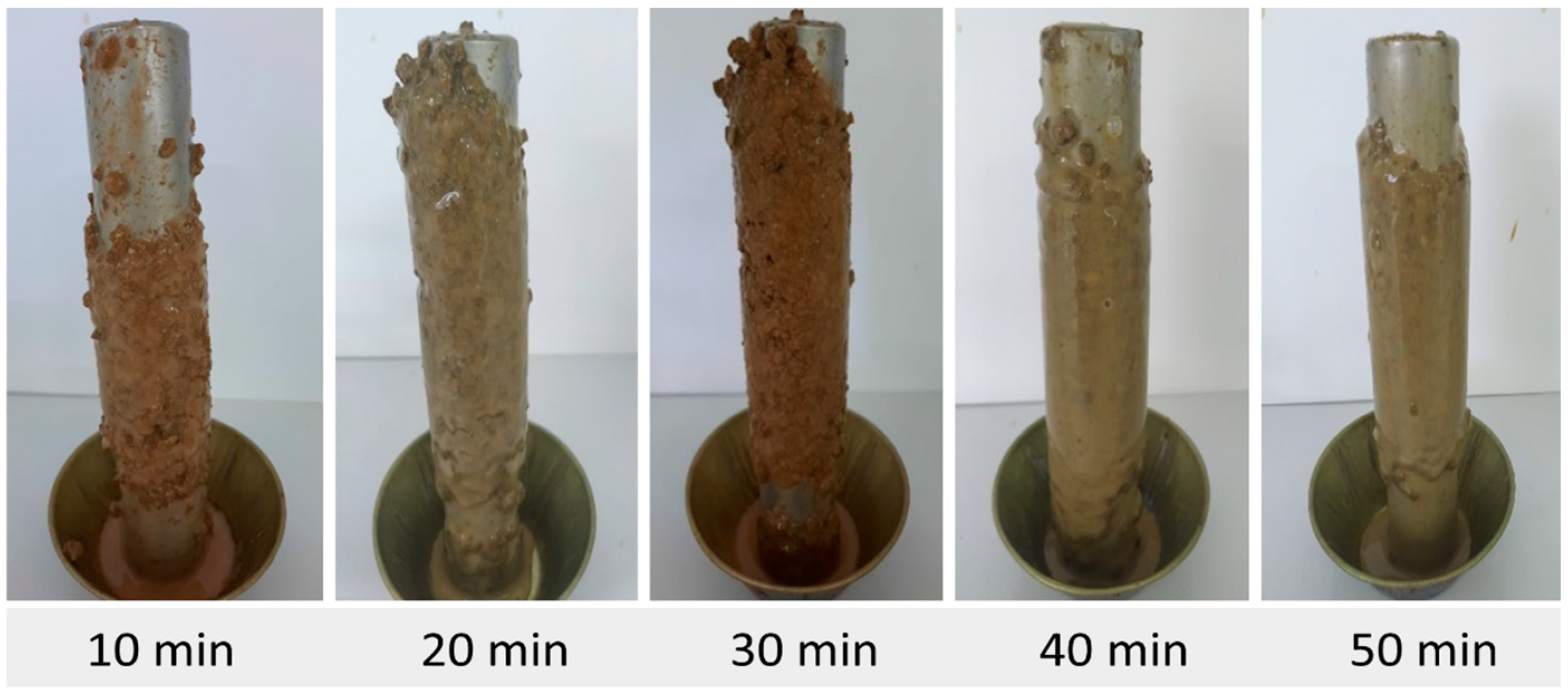
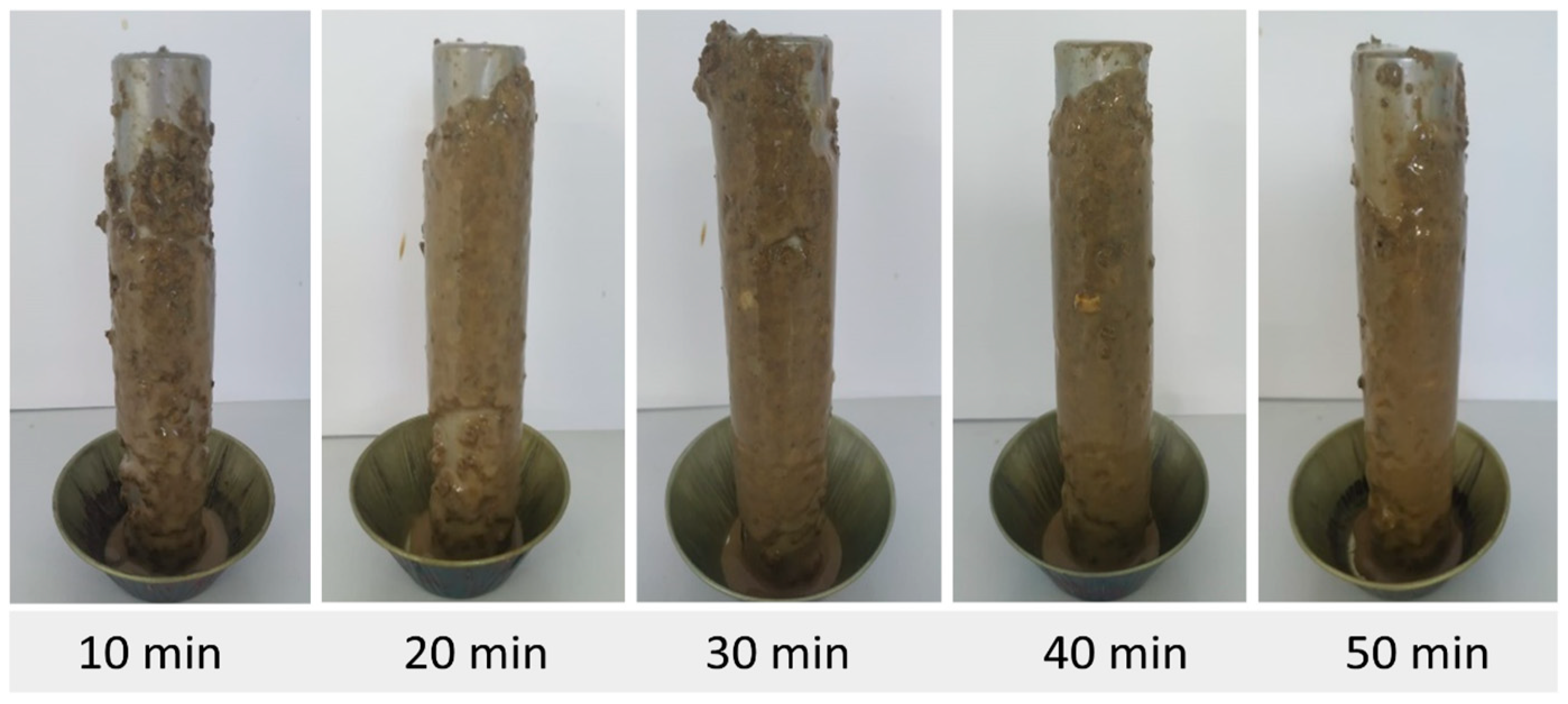
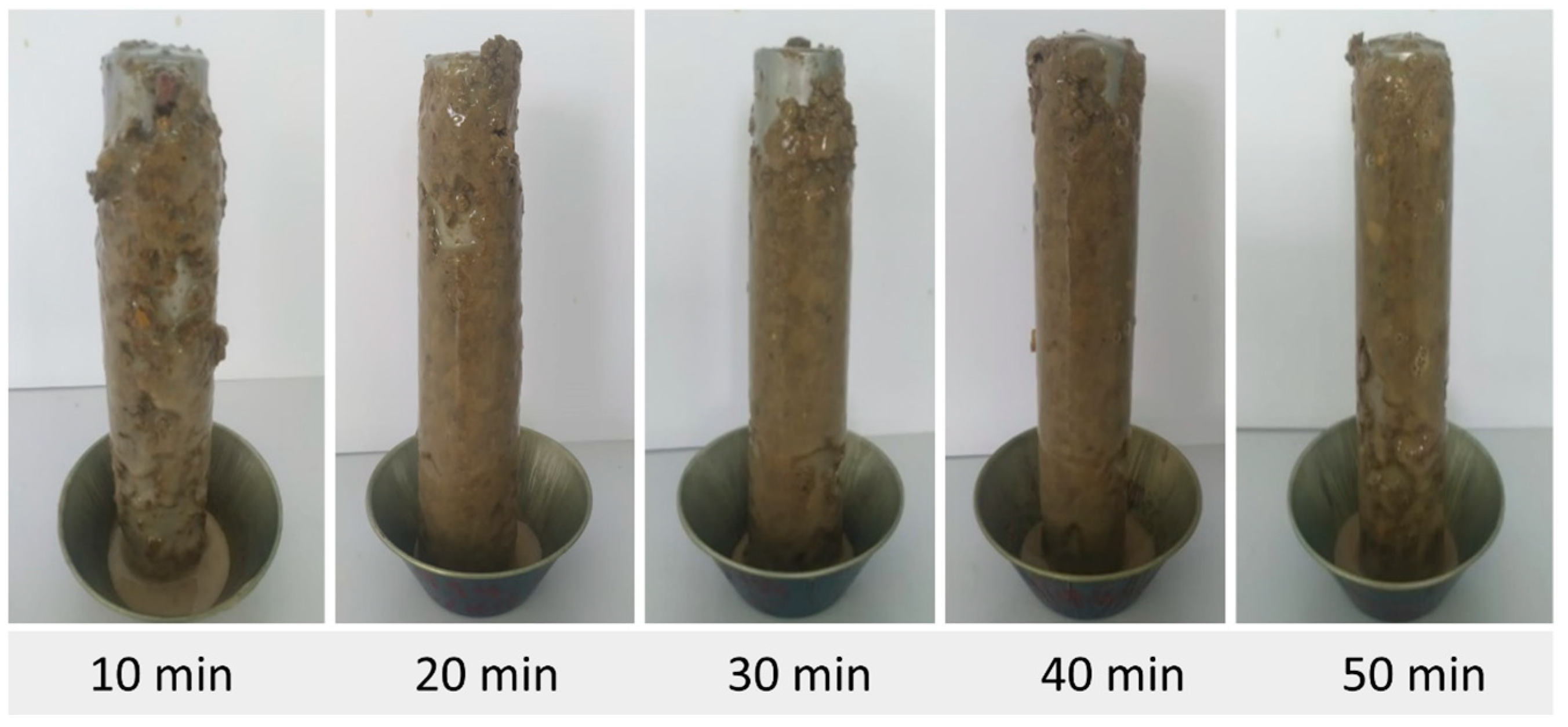
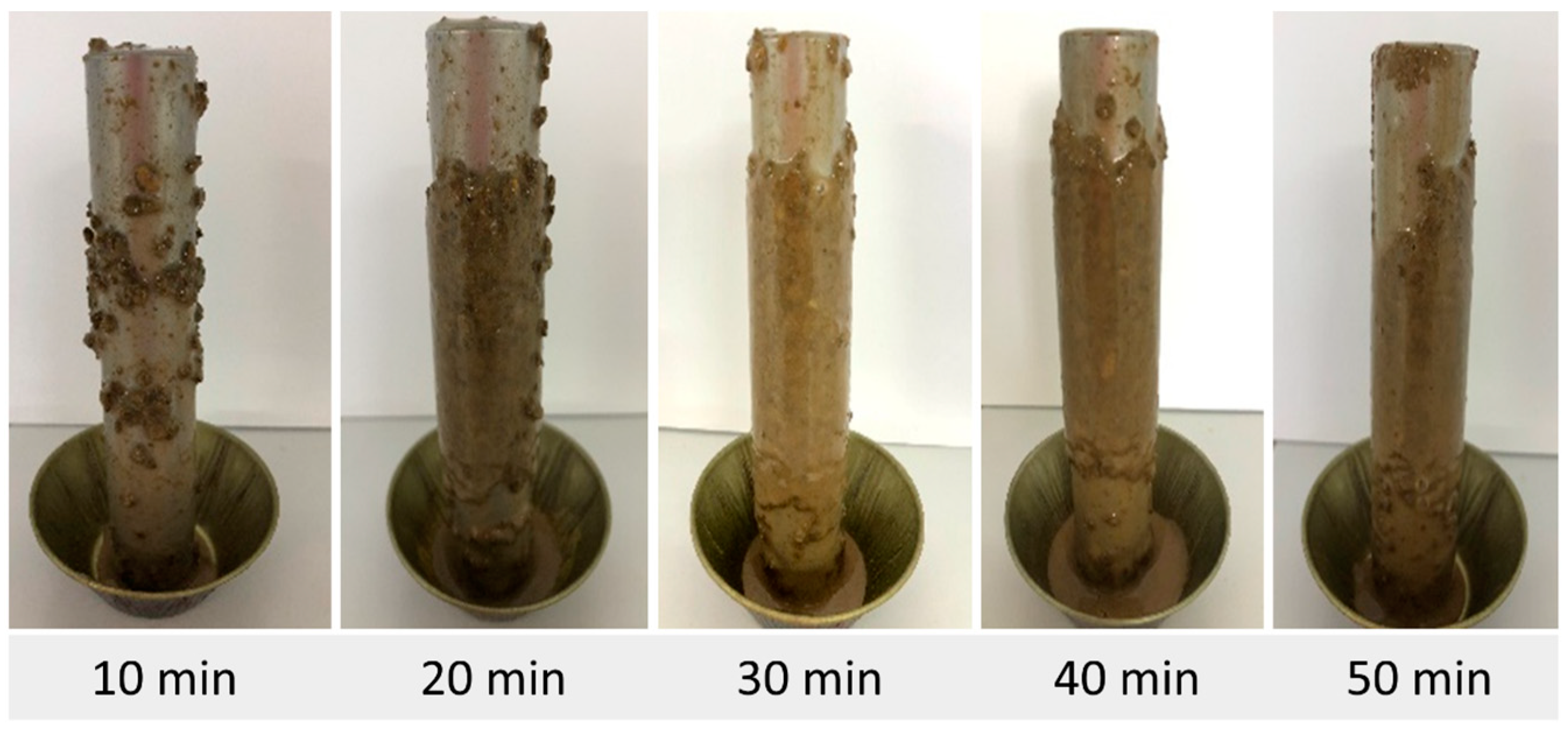

| Product | Function | Amount |
|---|---|---|
| Water | Dispersing medium | 262.5 mL |
| Sodium bicarbonate | Removal of divalent cations | 0.5 g |
| Glycerin | Dispersing medium | 87.5 mL |
| Xanthan gum | Rheological agent | 0.5 g |
| PAC LV | Filtrate loss reducer | 6 g |
| I1, I2, I3 ** | Clay swelling inhibitor | 15.7 g, 10.5 g, 10.5 g |
| Magnesium oxide | Alkalinity buffer | 1 g |
| Limestone | Bridging agent | 20 g |
| Silicone-based liquid | Anti-foaming | 0.3 g |
| NaCl | Weighting agent | QS * 9.5 lb/gal |
| Nomenclature | Glycerin Fluid |
|---|---|
| F1 | No inhibitor added |
| F2 | Added with I1 |
| F3 | Added with I1, I2, and I3 |
| F4 | Added with I1 and I2 |
| F5 | Added with I2 |
| F6 | Added with I1 and I3 |
| F7 | Added with I3 |
| Classification | Liquid Limit |
|---|---|
| Low plasticity | <35 |
| Intermediate plasticity | 35–50 |
| High plasticity | 50–70 |
| Very high plasticity | 70–90 |
| Extra high plasticity | >90 |
| Classification | Plasticity Index (%) |
|---|---|
| Weakly plastic | 1 < IP ≤ 7 |
| Moderately plastic | 7 < IP ≤ 15 |
| Highly plastic | IP > 15 |
| Liquid Medium | Plasticity Index (%) | Degree of Plasticity (%) |
|---|---|---|
| Water | 36 | Highly plastic |
| Glycerin | 5 | Weakly plastic |
| Glycerin + water | 22 | Highly plastic |
| Accretion (%) | |||||
|---|---|---|---|---|---|
| Glycerin Fluids | 10 min | 20 min | 30 min | 40 min | 50 min |
| F1 | 75.67 | 79.92 | 78.61 | 71.77 | 64.86 |
| F2 | 42.55 | 59.91 | 61.89 | 61.93 | 50.70 |
| F3 | 44.35 | 71.27 | 71.25 | 69.58 | 65.19 |
| F4 | 47.36 | 62.38 | 66.89 | 62.94 | 55.47 |
| F5 | 80.20 | 83.39 | 77.26 | 72.88 | 66.35 |
| F6 | 15.88 | 51.76 | 54.41 | 58.91 | 44.17 |
| F7 | 81.70 | 78.63 | 79.26 | 70.18 | 67.94 |
Disclaimer/Publisher’s Note: The statements, opinions and data contained in all publications are solely those of the individual author(s) and contributor(s) and not of MDPI and/or the editor(s). MDPI and/or the editor(s) disclaim responsibility for any injury to people or property resulting from any ideas, methods, instructions or products referred to in the content. |
© 2025 by the authors. Licensee MDPI, Basel, Switzerland. This article is an open access article distributed under the terms and conditions of the Creative Commons Attribution (CC BY) license (https://creativecommons.org/licenses/by/4.0/).
Share and Cite
Sousa, A.P.O.; Lima, M.C.S.; Costa, W.R.P.; Nascimento, R.C.A.M.; Delgado, J.M.P.Q.; Lima, A.G.B.; Amorim, L.V. Effect of Interaction Between Expandable Minerals and Glycerin-Based Fluids on the Occurrence of Accretion. Minerals 2025, 15, 245. https://doi.org/10.3390/min15030245
Sousa APO, Lima MCS, Costa WRP, Nascimento RCAM, Delgado JMPQ, Lima AGB, Amorim LV. Effect of Interaction Between Expandable Minerals and Glycerin-Based Fluids on the Occurrence of Accretion. Minerals. 2025; 15(3):245. https://doi.org/10.3390/min15030245
Chicago/Turabian StyleSousa, Ana P. O., Mário C. S. Lima, Waleska R. P. Costa, Renalle C. A. M. Nascimento, João M. P. Q. Delgado, Antonio G. B. Lima, and Luciana V. Amorim. 2025. "Effect of Interaction Between Expandable Minerals and Glycerin-Based Fluids on the Occurrence of Accretion" Minerals 15, no. 3: 245. https://doi.org/10.3390/min15030245
APA StyleSousa, A. P. O., Lima, M. C. S., Costa, W. R. P., Nascimento, R. C. A. M., Delgado, J. M. P. Q., Lima, A. G. B., & Amorim, L. V. (2025). Effect of Interaction Between Expandable Minerals and Glycerin-Based Fluids on the Occurrence of Accretion. Minerals, 15(3), 245. https://doi.org/10.3390/min15030245










